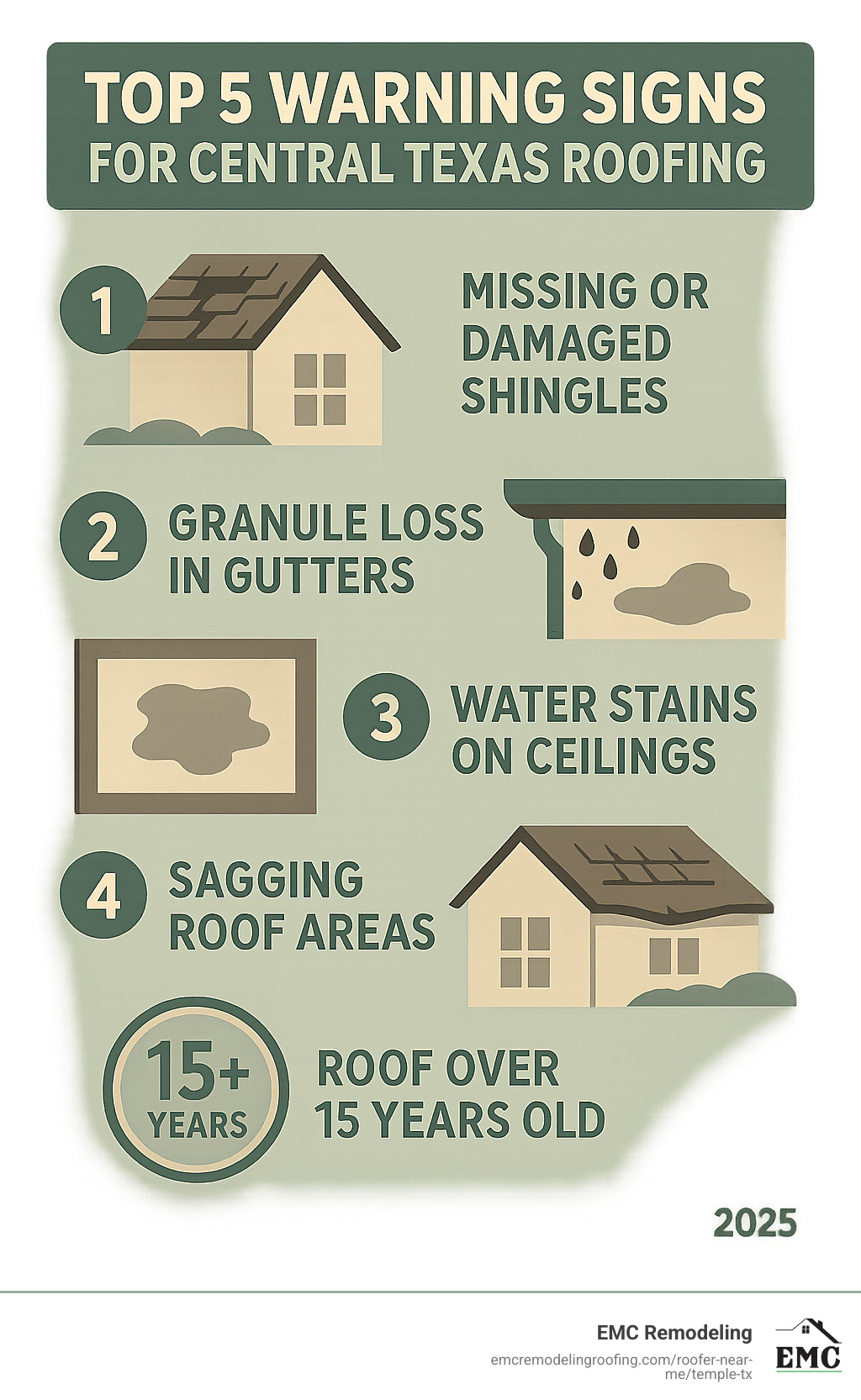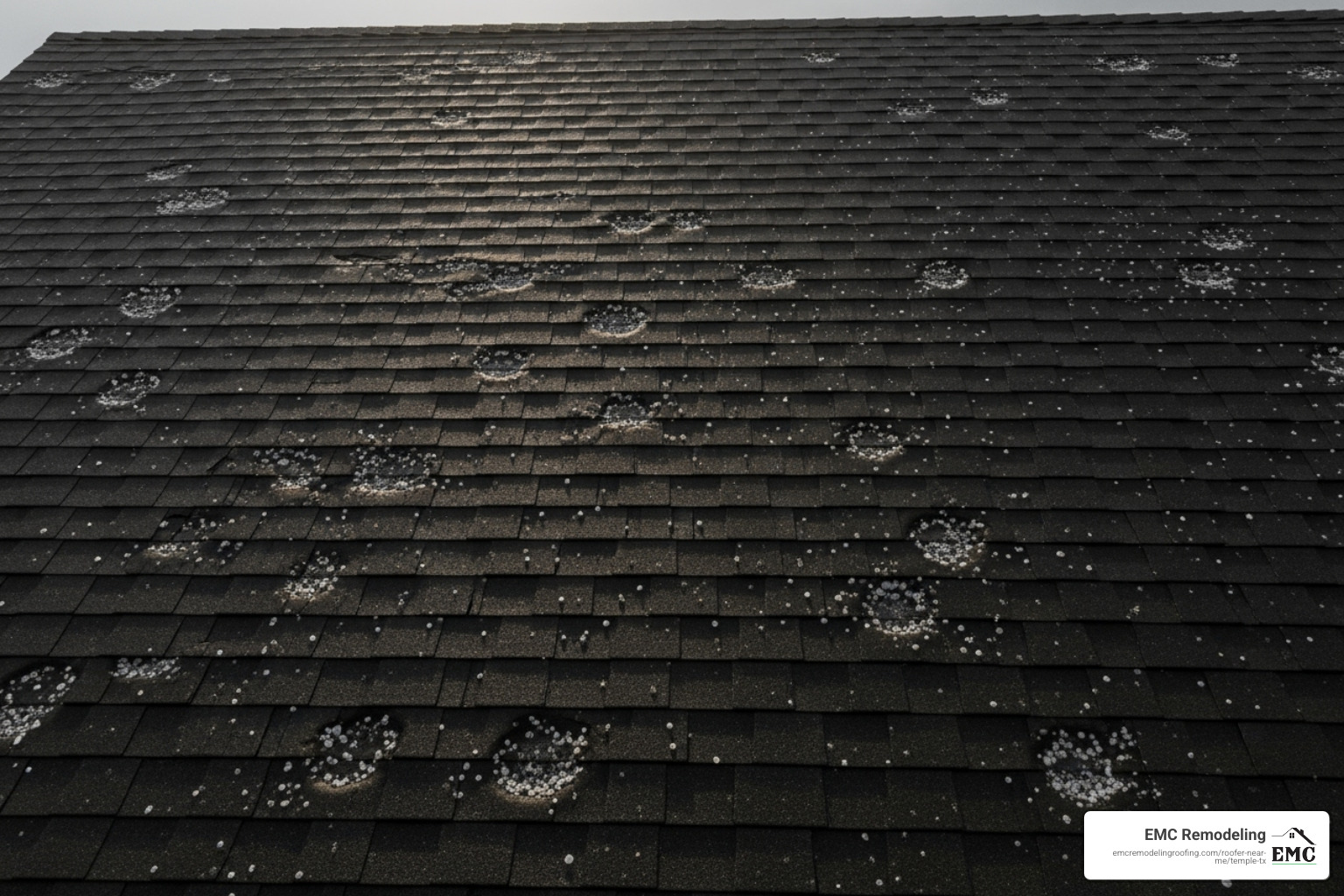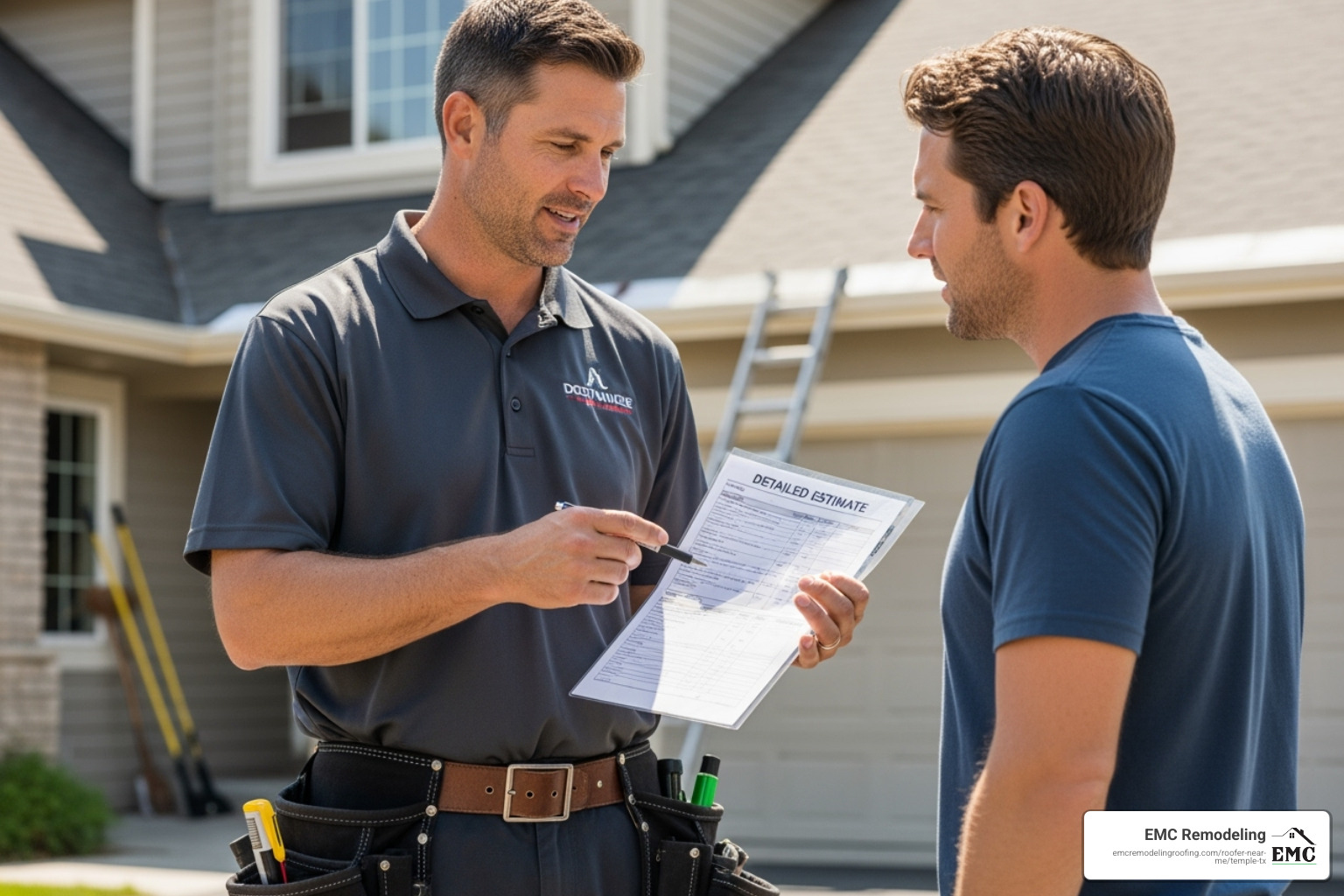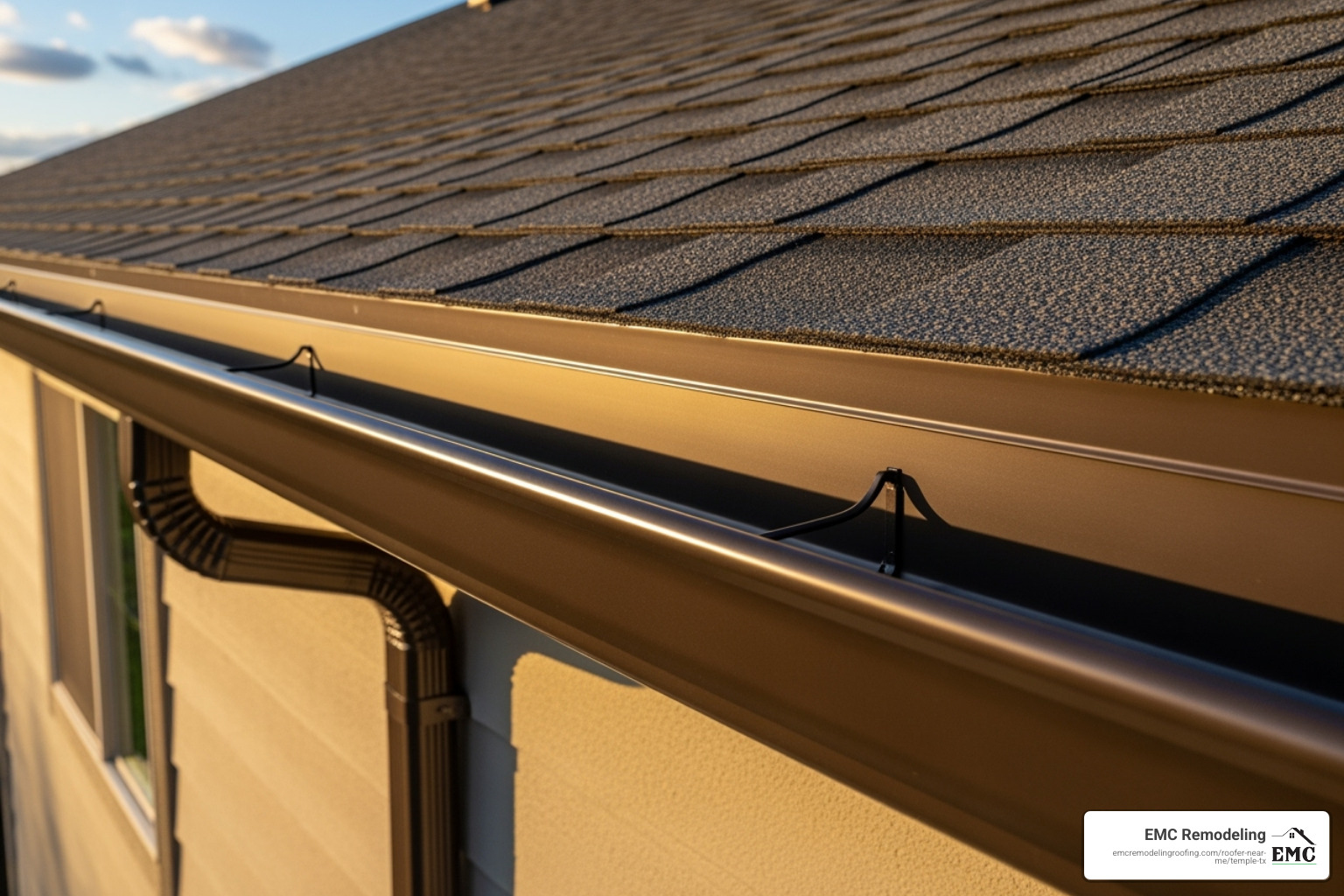Why Central Texas Roofing Requires Special Expertise
Central Texas roofing faces unique challenges that demand specialized knowledge. From devastating hailstorms in “Hail Alley” to scorching summer heat, your roof endures some of the harshest weather in the country. In fact, Texas consistently leads the nation in hail damage claims, making a durable roof a non-negotiable investment. The stakes are high, and the difference between a quality local contractor and a transient “storm chaser” can mean thousands of dollars and years of headaches.
Key Considerations for Central Texas Roofing Contractors:
- Local Experience: Choose contractors with proven experience serving Central Texas.
- Proper Certifications: Verify GAF or Owens Corning certifications, as Texas doesn’t require state licensing.
- Storm Damage Expertise: Essential for navigating insurance claims.
- Material Knowledge: Must understand which materials withstand Texas heat and storms.
- Warranty Protection: Look for both manufacturer and workmanship guarantees.
Your roof protects your most valuable investment: your home. Whether you’re dealing with storm damage or aging materials, choosing the right roofing contractor makes all the difference between a job done right and costly future repairs.
I’m Matt Runyon, President of EMC Remodeling & Roofing, and I’ve spent over 15 years helping Central Texas homeowners protect their homes with quality roofing solutions. My experience has taught me that success comes from understanding our unique climate and using proven materials and techniques.

Reading the Signs: When Does Your Central Texas Roof Need Help?
Your roof is constantly communicating its condition. In Central Texas roofing, where we face everything from baseball-sized hail to relentless summer heat, learning to read these warning signs can save you thousands.

The most obvious red flag is a leaking roof. Water stains on your ceiling are a cry for help, indicating water is getting past your roof’s defenses and potentially damaging insulation, drywall, and your home’s structure.
Other clear distress signals include:
- Missing shingles: Central Texas winds can rip shingles off, leaving your roof’s underlayment exposed.
- Granules in gutters: These asphalt granules protect shingles from UV damage. Finding them in your gutters means your roof is aging and losing its protective layer.
- Curling or cracking shingles: Years of heat can make shingles brittle, causing them to curl or crack, which prevents them from shedding water properly.
- A sagging roof deck: Any dips or sags in your roofline indicate serious structural issues that need immediate professional attention.
Common signs of storm damage on a Central Texas roofing system
Central Texas sits in “Hail Alley,” where severe weather can cause significant damage in minutes. After a storm, inspect for wind damage, where shingles are lifted, creased, or loosened. Water stains on your ceiling may appear days later as water slowly seeps in. Also, check for damaged flashing around chimneys and vents, as this metal barrier is a common failure point. Finally, debris on your roof like tree branches can trap moisture and promote algae growth, leading to premature aging.
Why roof age is a critical factor
Roofs aren’t immortal. Material degradation accelerates after the 15-year mark for most asphalt shingles in our climate. The constant UV exposure and temperature swings cause shingles to become brittle, which dramatically reduces their storm resistance. This brittleness is something we check with a simple test—if shingles snap easily, they’ve lost their protective qualities.
Furthermore, insurance eligibility can become an issue. Many insurers are reluctant to provide full replacement cost coverage for roofs over 15-20 years old, sometimes offering only a depreciated actual cash value. If you’re noticing multiple warning signs or your roof is approaching this critical age, it’s time to consider a professional inspection or replacement. Don’t wait for the next storm to test your roof’s limits.
Built to Last: Choosing the Right Roofing Materials for the Texas Climate
When it comes to Central Texas roofing, material selection is about choosing a warrior that can withstand our tough weather—from 100°F+ summers to surprise hailstorms. The right material balances durability, budget, and style.
Energy efficiency is a necessity, not a buzzword. With our high summer electricity bills, materials that reflect heat can lead to significant savings. Smart homeowners look beyond initial cost to consider long-term value from durability, wind resistance, and longevity.
The best materials for your Central Texas roofing needs
Asphalt Shingles: The most popular choice due to their value and versatility. For Central Texas, we recommend impact-resistant shingles with a Class 4 hail impact rating. These can handle hailstones up to 2 inches in diameter and may qualify you for insurance discounts.
Metal Roofing: A long-term solution lasting 40 to 70 years. Metal excels at heat reflection, reducing cooling costs by 10-25%, and offers superior wind resistance (up to 140 mph). Modern metal roofing comes in various styles, from sleek standing seam to shingles that mimic traditional materials.
Clay Tiles: Offer a classic Mediterranean or Spanish look and can last over 100 years. They are fire-resistant and provide excellent insulation. However, they are heavier, require a reinforced roof structure, and can be vulnerable to impact from very large hail.
Choosing the right material for your home is a balance of budget, aesthetics, and long-term performance. A material that costs more initially but lasts twice as long often provides better overall home value.
Energy efficiency and your roof
Your roof is a giant heat absorber. Cool roofing technology is designed to reflect more sunlight and absorb less heat, which directly translates to lower energy bills. These materials, including reflective metal and specially formulated asphalt shingles, can reduce roof surface temperatures by over 50°F.
Radiant barriers, reflective materials installed in your attic, block radiant heat from entering your living space. They act like sunscreen for your attic, reducing its temperature by up to 30°F and easing the load on your AC system.
Proper attic ventilation completes the system by allowing hot air to escape. The combination of reflective materials, a radiant barrier, and good ventilation creates a roof system that actively lowers utility bills and improves comfort.
Vetting the Pros: Your 7-Point Checklist for a Top Roofing Contractor
Choosing a roofing contractor can be daunting, especially with “storm chasers” arriving after every major weather event. This 7-point checklist will help you select a top-notch Central Texas roofing company.

- Local and Established: Look for a company with deep roots in the community and a physical office.
- Years in Business: A long track record indicates stability and experience with local climate challenges.
- Licensing and Insurance: Since Texas doesn’t require roofing licenses, reputable contractors will voluntarily obtain certifications and carry comprehensive liability and workers’ compensation insurance to protect you.
- Certifications: Manufacturer certifications from GAF or Owens Corning show that a contractor is trained to high standards and can offer improved warranties.
- Online Reviews and Reputation: Check independent review sites for consistent positive feedback on communication, quality, and service.
- Association Membership: Membership in groups like the Central Texas Roofing Contractors Association (CTRCA) shows a commitment to industry best practices.
- Warranties Offered: A great contractor offers both a manufacturer’s warranty on materials and their own workmanship warranty on the installation.
Why local and established is better
Choosing a local, established company for your Roofer near me in Austin, TX needs provides key advantages. Local contractors know the specific building codes and climate challenges. Their community reputation is on the line, and they’ll be available to honor warranty work years later. This helps you avoid the scams often associated with out-of-town storm chasers who disappear after the work is done.
Understanding warranties and certifications
A manufacturer’s warranty covers the roofing materials against defects. Elite certifications, like Owens Corning Platinum Preferred Contractor, allow contractors to offer extended, non-prorated warranties that can last 50 years or more. A workmanship warranty is provided by the contractor and covers the installation itself. Understanding both is crucial for comprehensive protection and peace of mind.
The Roofing Roadmap: What to Expect During Your Project
Starting a roofing project is a straightforward process when you know the steps. At EMC Remodeling, we believe in transparency to ensure a stress-free experience for every Central Texas homeowner.
- Initial Consultation & Free Inspection: We schedule a visit to thoroughly assess your roof’s condition, checking for both obvious damage and subtle wear.
- Detailed Estimate: You receive a clear, itemized estimate covering materials, labor, and timeline. We walk you through it to ensure you understand every detail.
- Insurance Claims Assistance: If storm damage is involved, our team helps you document damage and steer the claims process with your insurance adjuster.
- Permitting: We handle all the necessary paperwork and coordination with local municipalities to ensure your new roof meets all building codes.
- Installation: Our experienced crew works efficiently to install your new roof, typically in 1 to 3 days, while keeping your property protected.
- Site Cleanup: We believe in leaving your property cleaner than we found it, using magnetic sweepers to remove stray nails and debris.
- Final Walkthrough: We review the finished work with you, answer any questions, and ensure every detail meets our high standards.
Navigating insurance claims and financing
Dealing with insurance after a storm can be confusing. The key is to document damage with photos and videos immediately. Having an experienced roofer present when you meet with adjusters can ensure nothing is overlooked. It’s also vital to understand your policy—know your deductible and what’s covered before you need to file a claim. For projects not covered by insurance, financing options are available to make a quality roof affordable for most budgets.
Finding a reliable local contractor
In an industry with many transient operators, a trustworthy local contractor will have a physical office and be transparent with their information. We are invested in the community for the long haul.
EMC Remodeling
5100 Midway Dr Suite 211, Temple, TX 76502
(254) 760-9268
Protecting Your Investment: Long-Term Roof Care and Maintenance
Once your new roof is installed, proper care will ensure it lasts for decades. Think of it like a car: regular maintenance prevents costly breakdowns.

The foundation of roof care is regular inspections. We recommend a professional exam at least once a year and always after a major weather event like a hailstorm or severe windstorm. Proactive maintenance can extend a roof’s lifespan by up to 50%, turning a small investment in upkeep into thousands saved. Catching issues early is the difference between a minor repair and a major replacement.
Key maintenance tasks include:
- Gutter Cleaning: Clogged gutters cause water to back up onto your roof, accelerating aging and potentially damaging your home’s foundation.
- Debris Removal: Leaves and twigs trap moisture, creating ideal conditions for mold, algae, and rot. A clean roof is a healthy roof.
- Attic Ventilation Checks: Proper airflow in your attic prevents heat and moisture buildup that can warp your roof deck and increase cooling costs.
Staying on top of these tasks extends your roof’s lifespan and protects your entire home. Proactive repairs based on regular inspections prevent small problems from becoming expensive emergencies.
Frequently Asked Questions about Central Texas Roofing
Over years of serving Central Texas homeowners, we’ve found these questions come up most often. Here are the answers you need to make informed decisions.
How often should my roof be inspected in Central Texas?
In our storm-prone region, we recommend a professional inspection at least once a year and always after a major weather event (hail, high winds). Think of it as preventative care. Industry data shows that regularly inspected roofs last significantly longer, saving you thousands in premature replacement costs.
How long does a typical roof replacement take?
Most residential roof replacements take 1 to 3 days. The exact timeline depends on your home’s size and complexity, the roofing materials chosen, and, of course, the weather. A simple, single-story home may be done in a day, while a larger, more complex roof will take longer. We provide a realistic timeline upfront so you know exactly what to expect.
Will my homeowner’s insurance cover a new roof?
This depends on your policy and the cause of the damage. Most policies cover damage from sudden events like hailstorms, wind, or falling trees. They typically do not cover damage from old age or lack of maintenance. If your 25-year-old roof fails due to wear and tear, the replacement cost is usually your responsibility. An experienced Central Texas roofing contractor can help you document storm damage properly and steer the claims process to ensure you receive the coverage you’re entitled to.
Your Next Steps for a Storm-Proof Central Texas Roof
Your journey through Central Texas roofing doesn’t have to be complicated. Armed with the right knowledge, you can make smart decisions to protect your home for years to come.
The path forward is clear: stay vigilant for warning signs like missing shingles or granules in your gutters. If your roof is over 15 years old, start planning proactively. When choosing materials, balance value with long-term durability for our climate. Most importantly, vet your contractor thoroughly. Look for local expertise, proper certifications, and solid warranties to guarantee quality work.
Maintenance is your roof’s best friend. Annual inspections and post-storm check-ups are small investments that prevent big problems.
For comprehensive exterior solutions—including siding, gutters, and windows—from a trusted local expert in Temple, TX, consider EMC Remodeling. We leverage our deep knowledge of local weather and building codes to deliver solutions that last.
Ready to protect your home with a roof that can handle anything Central Texas throws its way? Explore our roofing services and get your free estimate today. Your home deserves protection that stands the test of time and Texas weather.
